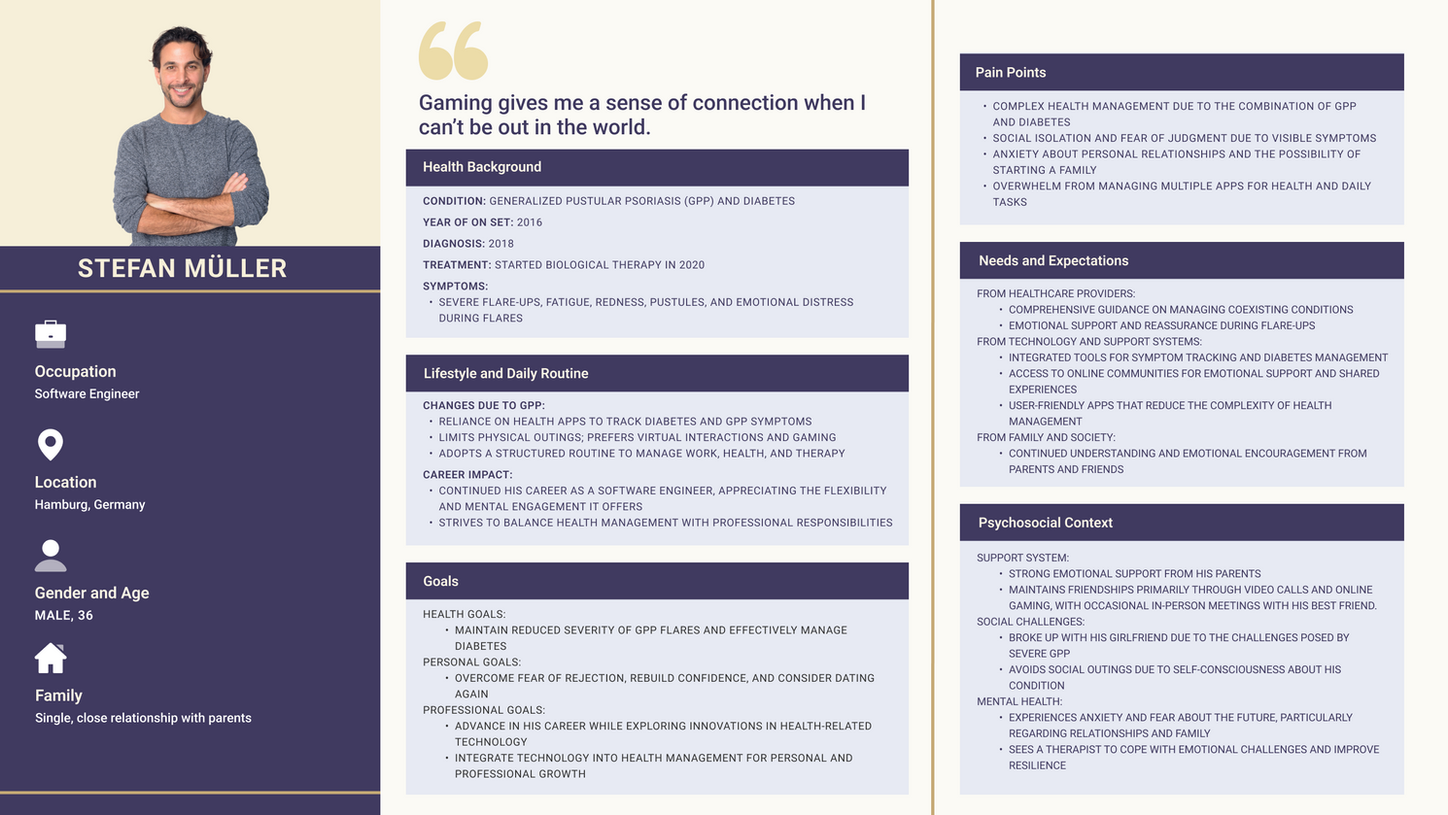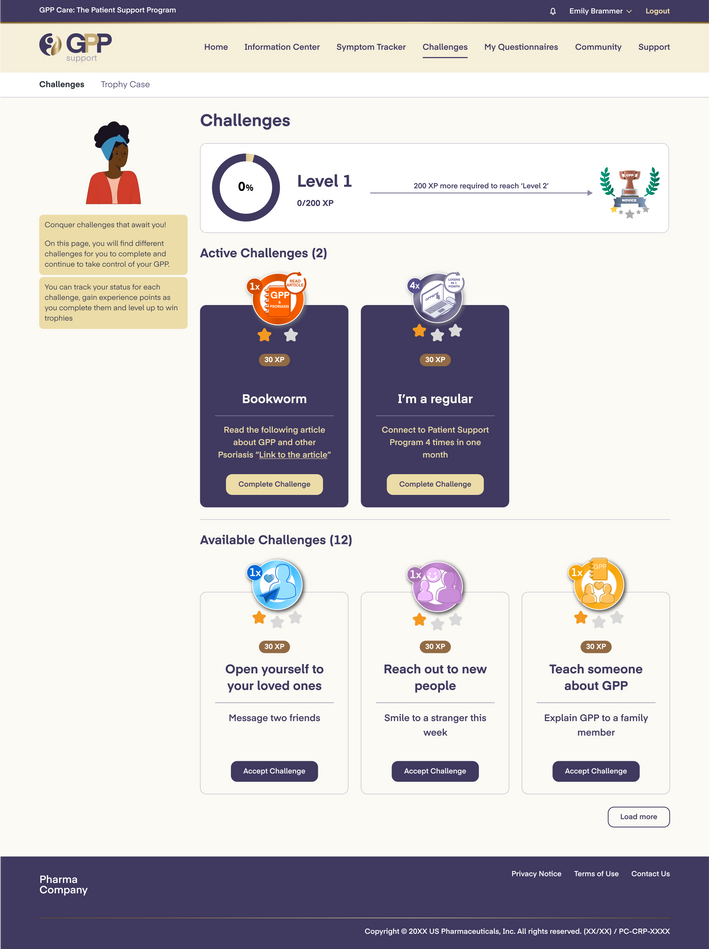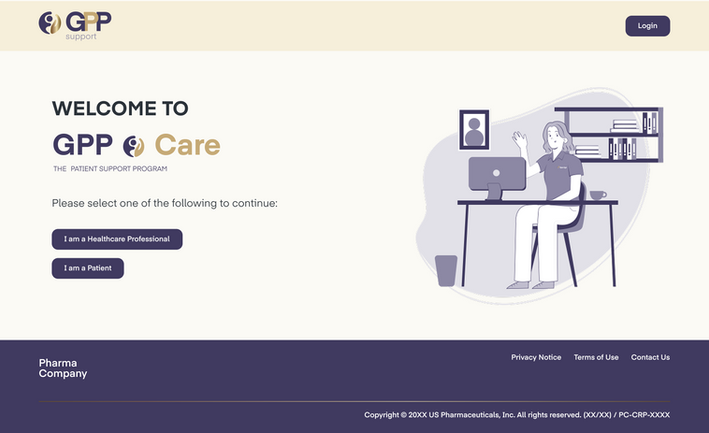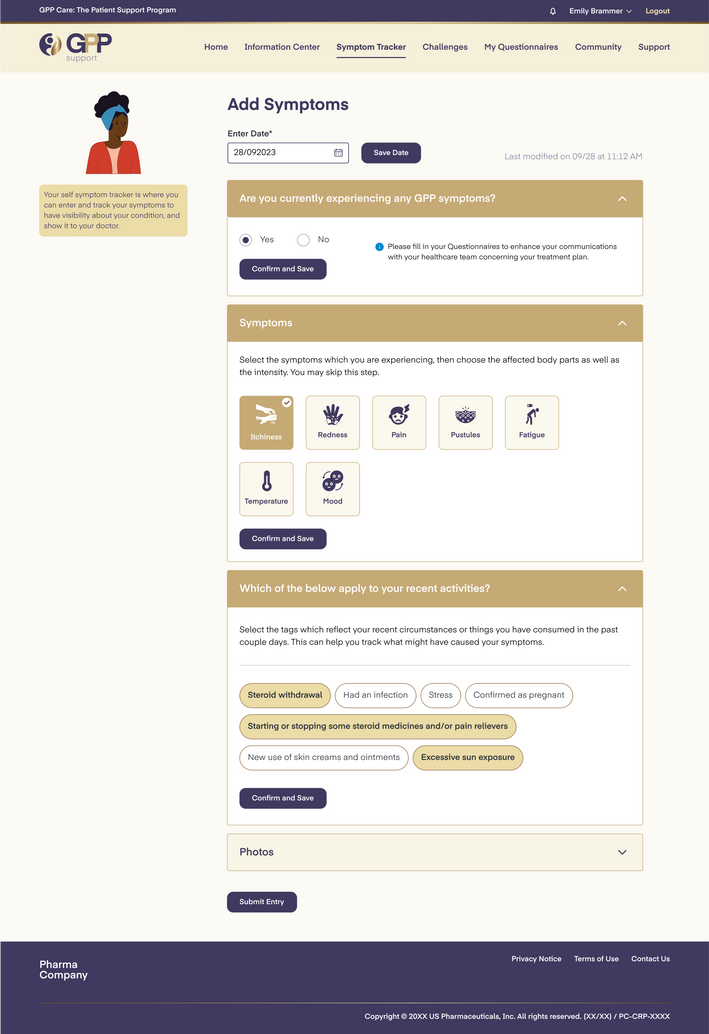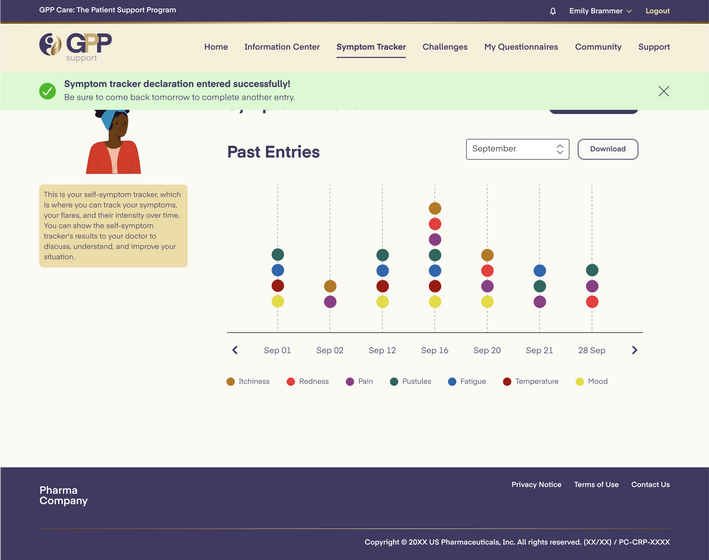
Patient Support Program Website
Timeline
6 Months
Tools
Figma, Jira, Microsoft Teams, Microsoft Excel
Team
5 members
Overview
This project focused on developing a Patient Support Program (PSP) website tailored for individuals living with GPP. The platform incorporated interactive and engaging features, including educational resources, symptom tracking, and motivational tools, to empower patients in managing their condition. By leveraging research-driven design, user-centric features, and collaborative input, the website aimed to provide a seamless and supportive experience for GPP patients, helping them take meaningful actions to improve their quality of life.
Challenge
Strategize, concept, and execute a sound patient support program to drive patient engagement, community, and adherence.
Patients managing GPP live a fragmented healthcare experience—overwhelmed, unsupported, and burdened by the complexities of their condition. Tracking symptoms, adhering to medications, and remembering appointments often become inconsistent amidst daily struggles.
This ongoing strain leads to missed logs, skipped medications, and forgotten appointments—further distancing patients from timely care and deepening their sense of isolation.
Solution
We created a patient support platform that feels intuitive and comforting—like a trusted space, not a clinical tool.
-
Mapped patient journeys to identify real pain points
-
Crafted a retreat-like experience with calm, empowering visuals
-
Designed tools for tracking, reminders, and self-guided support
-
Used PET techniques to encourage positive habits
-
Tested UI with patients using visual comprehension methods
The result: A platform that supports, motivates, and helps GPP patients feel in control.
My Roles and Responsibility
I was responsible for ideating and conceptualizing feature designs to ensure that patients with Generalized Pustular Psoriasis (GPP) could effectively engage with and benefit from the platform. My role involved blue-sky thinking, collaborative ideation, and ensuring that the design aligned with both patient needs and business objectives.
Key contributions:
-
Conducted research on GPP, patient needs, and their journey to inform feature development.
-
Helped create journey maps and personas to better understand patient behaviors and motivations.
-
Defined user stories and translated them into detailed Jira tickets with clear design requirements, collaborating closely with developers, project managers, and business analysts, and finalizing them through client workshops
-
Led workshops with the client to present user stories and gather feedback before starting the design process.
-
Ensured 1:1 compliance between user stories, Jira tickets, and final designs to maintain alignment.
-
Designed features that enhanced the patient journey, offering motivation and support to encourage proactive disease management by applying PET (Persuasive, Emotional, Trust) design techniques

Before starting the project lets get to know about the users.
A Day in the Life of a Patient with GPP
Living with Generalized Pustular Psoriasis (GPP) feels like navigating an unrelenting storm. Each day begins with pain—skin inflamed, movements agonizing, and a mirror reflecting not just physical symptoms but emotional scars of frustration and isolation.
Simple tasks become battles: dressing carefully to avoid irritation, cooking through joint pain, or facing the world despite fear of judgment. Flare-ups are unpredictable, disrupting work, social life, and even the smallest plans.
Managing GPP demands vigilance—tracking triggers, medications, and appointments—yet exhaustion often derails these efforts. By night, the toll is overwhelming, leaving patients physically drained and emotionally isolated. GPP impacts far beyond the skin, shaking every aspect of life and demanding strength to persevere.
The Design Process
We started by researching patient support programs from other pharma brands in the US, even beyond GPP, to gather best practices. Then, using detailed personas and journey maps, we identified GPP patients’ daily struggles, uncovering pain points and opportunities to design tools that truly support their needs
Discovery
Conducted design research on various US-based patient support programs offered by pharma companies for different therapeutic areas and purposes

Every great design starts with a journey
Tracing the disease progression and its real-life impact on patients



Personas
Design that connects starts with a persona that resonates
Created detailed personas of a male and female patient, capturing their daily lives, how the condition affects them, and their personal goals.
Journey Map
Developed individual journey maps illustrating how GPP impacts every aspect of their lives—including life pathways, emotional journeys, medical touchpoints, and an integrated global view combining all three

Ideation
Now that we understood patient needs, we aimed to create a PSP platform that felt like a retreat—a safe, supportive space where patients could feel empowered, in control, and ready to take action. To bring this vision to life, we conducted co-creation sessions with clients to ideate on key features, and collaboratively translated those ideas into user stories to guide design and development
From Vision to Reality
Conceptualizing Features to Empower Every Step

Guiding Avatar
A customizable guiding avatar that appears on every page that assists users with exploring website features, assisting them to complete tasks and navigate the website
PET technique used:


Dashboard
A user-friendly dashboard provides patients with a quick glance at essential information.
PET technique used:
Symptom Tracker
The symptom tracker enables patients to log their symptoms consistently, including itch levels, pain intensity, fever, and mood fluctuations. By regularly entering this data, patients gain valuable insights into their health trends, allowing for more informed discussions with their healthcare providers during appointments.
PET technique used:


Disease education
a comprehensive library of articles tailored to GPP patients, covering topics such as disease awareness, treatment options, and effective communication strategies with healthcare professionals. By empowering patients with knowledge, we aim to enhance their confidence in managing their condition.
PET technique used:
Questionnaires
To continuously assess the health and well-being of patients, we implemented a system of monthly and weekly questionnaires. These questionnaires gather feedback on patients' symptoms, mental well-being, and overall satisfaction with the website. This ongoing engagement allows for timely adjustments to the platform based on user needs and enhances the personalized experience for each patient.
PET technique used:


Gamification
a series of engaging challenges designed to motivate patients to explore its features actively. These challenges encourage users to complete tasks such as tracking their symptoms regularly, reading articles, and participating in community discussions. Each completed challenge contributes to a sense of accomplishment and can lead to rewards, fostering a sense of community and support among users.
PET technique used:
Community
A feature where users can post a set of predefined statements and tasks and where other users can react to them. this fosters a sense of community and help users not fell alone
PET technique used:

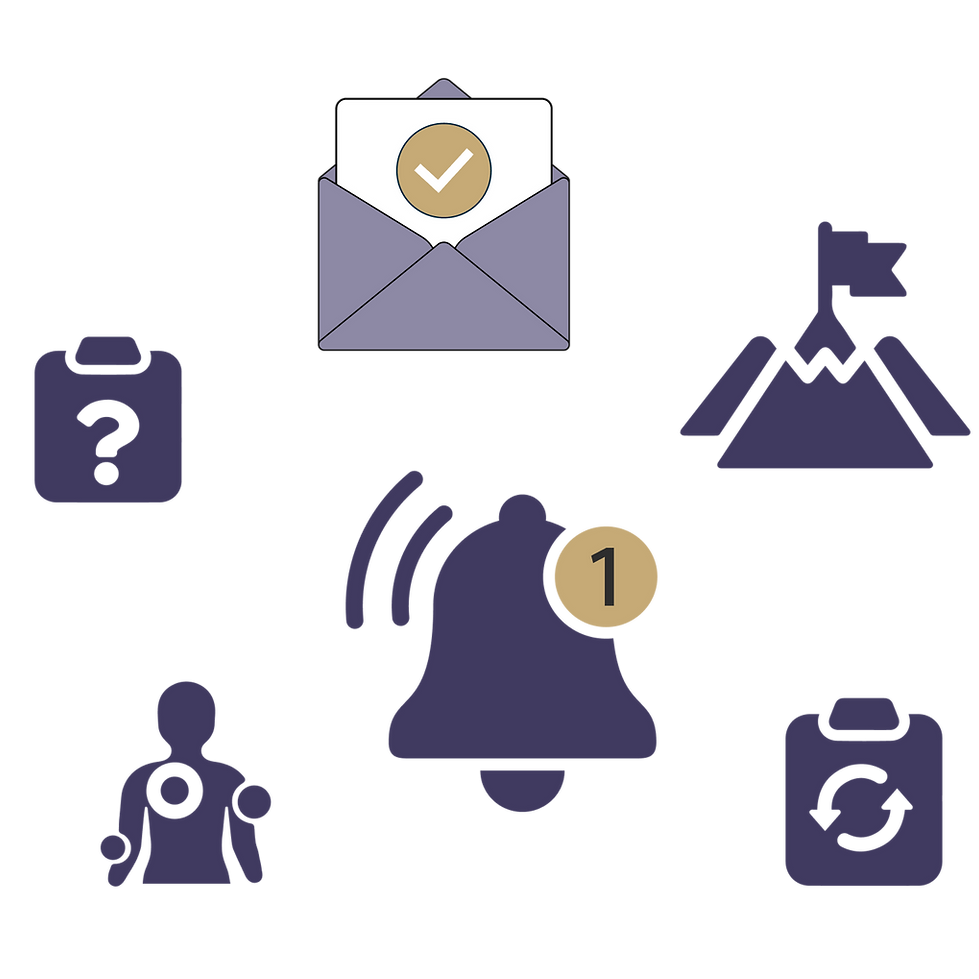
Reminders
This feature reminds user of their next appointments and when they will have to refill their medication, help track symptoms regularly and fill questionnaires
PET technique used:
Personalization
Users will be able to answer a set of questions and based on their answers the platform will be personalized to their liking and show information that are critical to them and alter challenges presented based on their needs
PET technique used:


Support center
A place where users can ask for help related to medication, GPP and platform.
PET technique used:
Crafting the Flow, Powering the Process
From Ideas to Actions :
Mapped task flows and site architecture to visualize how individual features interact, align across the platform, and collectively enhance the overall patient experience.

Shaping Ideas into Structure
Where Concepts Take Shape
We brought the ideas to life through wireframes, illustrating how each feature would work and fit within the platform. During client workshops, these wireframes sparked meaningful discussions, helping us refine the experience. We also partnered closely with MLR teams to ensure everything—from data collection to feature behavior—met legal, compliance, and regulatory standards.

Tranquil Trails: Steps Toward Lasting Care
We began by shaping the essence and atmosphere of the PSP, crafting a space that resonates deeply with GPP patients—a place of calm, connection, and care
Designing visual identity
We carefully selected colors that are both expressive and accessible—ensuring proper usage by following WCAG 2.1 POUR principles and maintaining sufficient contrast ratios for AA standards. Collaborating with the brand and graphic design teams, we crafted custom diverse avatars, challenge badges, trophies and illustrations.
These elements were reviewed and approved during client workshops and implemented in the high-fidelity prototypes to create a cohesive, patient-friendly experience.

Bringing Concepts to Life
Crafting Pixel-Perfect Realities
User testing - Patient Visual Comprehension Testing
We conducted user testing sessions with patients using static visual mockups to evaluate their comprehension and ease of navigation. Participants were shown key images representing the intended user interface and were asked whether they could understand the visual information and locate specific elements.








The Ripple Effect: Turning Drops into Waves
The qualitative impact of our behavioral change and gamification strategies
I finally understand how my habits affect my condition.
- Patient 1
It’s such a relief not to worry about missing a dose.
- Patient 2
Seeing my progress keeps me motivated
- Patient 3
My doctor adjusted plan for my daughter based on the tracker—it changed everything.
- Caregiver
I feel less alone and more informed about GPP.
- Patient 4
Empowerment
Patients feel in control of their health with tools to track symptoms and identify patterns.
Reduced Stress
Automated reminders ease the mental burden of managing medications and appointments.
Improved Outcomes
Consistent tracking and gamified rewards encourage adherence to treatments.
Better Doctor Communication
Logs help patients share clear insights with healthcare providers.
Support and Knowledge
Resources and FAQs reduce isolation and build confidence.
From Sparks to Milestone
Design timeline for this entire project
Reflections
Design is not just about how it looks, but how it works and transforms behavior
01
No matter how Complex healthcare problems might be it can have intuitive solutions
02
Behavioural design strategies does work if they are applied correctly.
03
Collaboration with users and cross functional teams is essential to delivering a thoughtful patient first design.
Conclusion
The project resulted in a user-friendly, engaging platform that combined design and behavior change strategies to empower patients. By addressing adherence challenges and symptom management, we laid the groundwork for healthier habits and improved healthcare experiences.

